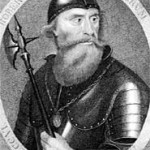 On this day in 1329, King of Scots from 25 March 1306, until his death, one of Scotland’s greatest kings and one of the most famous warriors of his generation, one of Scotland’s national heroes, Robert the Bruce, Robert I died on 7 June 1329, at the Manor of Cardross, near Dumbarton at the age of 54. Born 11 July 1274 most likely in Turnberry Castle in Ayrshire, the head of his mother’s earldom. Robert led Scotland during the Wars of Scottish Independence against England. He fought successfully during his reign to regain Scotland’s place as an independent nation.
On this day in 1329, King of Scots from 25 March 1306, until his death, one of Scotland’s greatest kings and one of the most famous warriors of his generation, one of Scotland’s national heroes, Robert the Bruce, Robert I died on 7 June 1329, at the Manor of Cardross, near Dumbarton at the age of 54. Born 11 July 1274 most likely in Turnberry Castle in Ayrshire, the head of his mother’s earldom. Robert led Scotland during the Wars of Scottish Independence against England. He fought successfully during his reign to regain Scotland’s place as an independent nation.

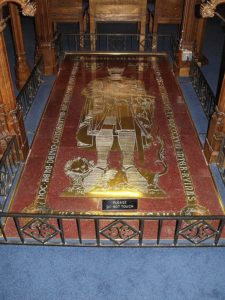
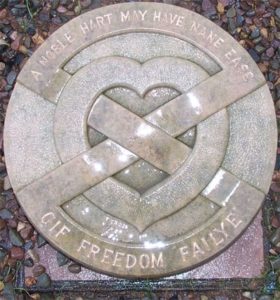 The Final Footprint – Robert’s final wish reflected conventional piety, and was perhaps intended to perpetuate his memrory. After his death his heart was to be removed from his body and borne by a noble knight on a crusade against the Saracens and carried to the Church of the Holy Sepulchre in Jerusalem, before being brought back to Scotland. He died utterly fulfilled, in that the goal of his lifetime’s struggle, untrammelled recognition of the Bruce right to the crown, had been realised, and confident that he was leaving the kingdom of Scotland safely in the hands of his most trusted lieutenant, Moray, until his infant son reached adulthood. Six days after his death, to complete his triumph still further, papal bulls were issued granting the privilege of unction at the coronation of future Kings of Scots.
The Final Footprint – Robert’s final wish reflected conventional piety, and was perhaps intended to perpetuate his memrory. After his death his heart was to be removed from his body and borne by a noble knight on a crusade against the Saracens and carried to the Church of the Holy Sepulchre in Jerusalem, before being brought back to Scotland. He died utterly fulfilled, in that the goal of his lifetime’s struggle, untrammelled recognition of the Bruce right to the crown, had been realised, and confident that he was leaving the kingdom of Scotland safely in the hands of his most trusted lieutenant, Moray, until his infant son reached adulthood. Six days after his death, to complete his triumph still further, papal bulls were issued granting the privilege of unction at the coronation of future Kings of Scots.
The king’s body was embalmed and his sternum was sawn to allow extraction of the heart, which Sir James Douglas placed in a silver casket to be worn on a chain around his neck. The body was taken to Dunfermline Abbey, and Robert the Bruce was entombed in what was then the very centre of the abbey, beneath the high altar, and beside his queen. The king’s tomb was carved in Paris by Thomas of Chartres from alabaster brought from England and was decorated with gold leaf. The tomb was transported to Dunfermline via Bruges and was erected over the king’s grave in the autumn of 1330. Ten alabaster fragments from the tomb are on display in the National Museum of Scotland and traces of gilding still remain on some of them.
When a projected international crusade failed to materialise, Douglas and his company sailed to Spain where Alfonso XI of Castile was mounting a campaign against the Moorish kingdom of Granada. Douglas was killed in battle during the siege of Teba in August 1330 while fulfilling his promise. His body and the casket containing the embalmed heart were found together upon the field. They were both conveyed back to Scotland by Sir William Keith of Galston. In accordance with Bruce’s written request, the heart was buried at Melrose Abbey in Roxburghshire. In 1920, the heart was discovered by archaeologists and was reburied, but the location was not marked. In 1996, a casket was unearthed during construction work. Scientific study by AOC archaeologists in Edinburgh, demonstrated that it did indeed contain human tissue and it was of appropriate age. It was reburied in Melrose Abbey in 1998, pursuant to the dying wishes of the King.
Portrayed in Mel Gibson’s film Braveheart by Angus Macfadyen.
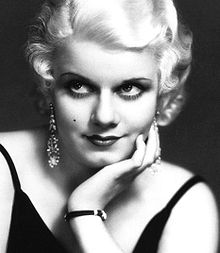 On this day in 1937, actress, Baby, the Blonde Bombshell, the Platinum Blonde, Jean Harlow died of renal failure in Good Samaritan Hospital in Los Angeles at the age of 26. Born Harlean Harlow Carpenter on 3 March 1911 in Kansas City, Missouri. Howard Hughes signed Harlow to a contract and she appeared in his film Hell’s Angels (1930). She was one of the biggest stars in Hollywood in the 1930’s and appeared in five films with Clark Gable. Harlow married three times: Charles McGrew (1927-1929 divorce), Paul Bern (1932-1932 his death), Harold Rosson (1933-1934 divorce). After her third marriage ended in 1934, Harlow met William Powell, another MGM star, and quickly fell in love. Reportedly the couple were engaged for two years, but differences kept them from formalizing their relationship (she wanted children; he did not). Harlow also said that Louis B. Mayer would never allow them to marry.
On this day in 1937, actress, Baby, the Blonde Bombshell, the Platinum Blonde, Jean Harlow died of renal failure in Good Samaritan Hospital in Los Angeles at the age of 26. Born Harlean Harlow Carpenter on 3 March 1911 in Kansas City, Missouri. Howard Hughes signed Harlow to a contract and she appeared in his film Hell’s Angels (1930). She was one of the biggest stars in Hollywood in the 1930’s and appeared in five films with Clark Gable. Harlow married three times: Charles McGrew (1927-1929 divorce), Paul Bern (1932-1932 his death), Harold Rosson (1933-1934 divorce). After her third marriage ended in 1934, Harlow met William Powell, another MGM star, and quickly fell in love. Reportedly the couple were engaged for two years, but differences kept them from formalizing their relationship (she wanted children; he did not). Harlow also said that Louis B. Mayer would never allow them to marry.
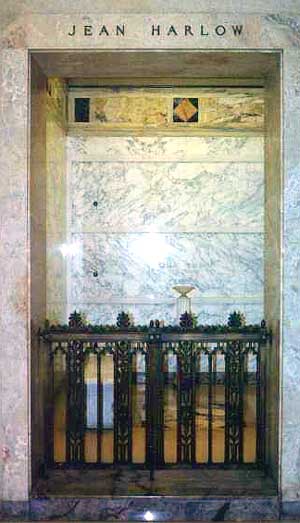 The Final Footprint – Harlow is entombed in a private family room in the Great Mausoleum at Forest Lawn Memorial Park, Glendale, California. Her crypt is lettered; OUR BABY. She was buried in the gown she wore in Libeled Lady and in her hands she held a white gardenia and a note which Powell had written: “Goodnight, my dearest darling.” Spaces in the same room were reserved for Harlow’s mother and Powell. Harlow’s mother was entombed there in 1958, but Powell remarried in 1940 and after his death in 1984 was cremated: his ashes were scattered over the Palm Springs Desert area. Gable was a pallbearer. Other notable Final Footprints at Forest Lawn Glendale include; L. Frank Baum, Humphrey Bogart, Lon Chaney, Nat King Cole, Dorothy Dandridge, Sammy Davis, Jr., Sam Cooke, Walt Disney, Errol Flynn, Clark Gable, Michael Jackson, Carole Lombard, Tom Mix, Casey Stengel, Jimmy Stewart, Elizabeth Taylor, and Spencer Tracy.
The Final Footprint – Harlow is entombed in a private family room in the Great Mausoleum at Forest Lawn Memorial Park, Glendale, California. Her crypt is lettered; OUR BABY. She was buried in the gown she wore in Libeled Lady and in her hands she held a white gardenia and a note which Powell had written: “Goodnight, my dearest darling.” Spaces in the same room were reserved for Harlow’s mother and Powell. Harlow’s mother was entombed there in 1958, but Powell remarried in 1940 and after his death in 1984 was cremated: his ashes were scattered over the Palm Springs Desert area. Gable was a pallbearer. Other notable Final Footprints at Forest Lawn Glendale include; L. Frank Baum, Humphrey Bogart, Lon Chaney, Nat King Cole, Dorothy Dandridge, Sammy Davis, Jr., Sam Cooke, Walt Disney, Errol Flynn, Clark Gable, Michael Jackson, Carole Lombard, Tom Mix, Casey Stengel, Jimmy Stewart, Elizabeth Taylor, and Spencer Tracy.
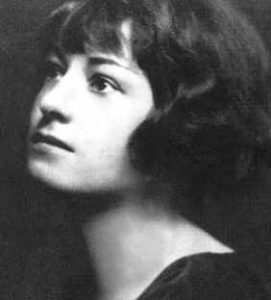 On this day in 1967, poet, writer, screenwriter, critic, and satirist Dorothy Parker died of a heart attack in New York City, at the age of 73. Born Dorothy Rothschild on August 22, 1893 in Long Branch New Jersey. Perhaps best known for her wit, wisecracks, and eye for 20th-century urban foibles.
On this day in 1967, poet, writer, screenwriter, critic, and satirist Dorothy Parker died of a heart attack in New York City, at the age of 73. Born Dorothy Rothschild on August 22, 1893 in Long Branch New Jersey. Perhaps best known for her wit, wisecracks, and eye for 20th-century urban foibles.
From a conflicted and unhappy childhood, Parker rose to acclaim, both for her literary works published in such magazines as The New Yorker and as a founding member of the Algonquin Round Table. Following the breakup of the circle, Parker traveled to Hollywood to pursue screenwriting. Her successes there, including two Academy Award nominations, were curtailed when her involvement in left-wing politics resulted in her being placed on the Hollywood blacklist.
Dismissive of her own talents, she deplored her reputation as a “wisecracker”. Nevertheless, both her literary output and reputation for sharp wit have endured. Some of her works have been set to music; adaptations notably include the operatic song cycle Hate Songs by composer Marcus Paus.
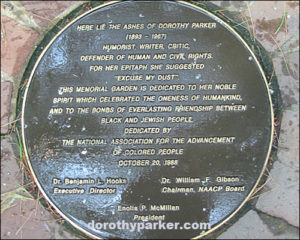 The Final Footprint
The Final Footprint
In her will, she bequeathed her estate to Martin Luther King Jr. Following King’s death, her estate was bequeathed by his family to the NAACP. Her executor, Lillian Hellman, unsuccessfully contested this disposition. She was cremated. Her cremated remains remained unclaimed in various places, including her attorney Paul O’Dwyer’s filing cabinet, for approximately 17 years. A portion of her cremated remains are interred at the Dorothy Parker Memorial Garden, Baltimore. She proposed “Excuse My Dust” as her epitaph.
Quotes…
- Too fucking busy, and vice versa.
- Response to an editor pressuring her for overdue work, as quoted in The Unimportance of Being Oscar (1968) by Oscar Levant, p. 89
- It serves me right for putting all my eggs in one bastard.
- On her abortion, as quoted in You Might as well Live by John Keats (1970)
- You can lead a horticulture, but you can’t make her think.
- Parker’s answer when asked to use the word horticulture during a game of Can-You-Give-Me-A-Sentence?, as quoted in You Might as well Live by John Keats (1970).
- What fresh hell can this be?
- “If the doorbell rang in her apartment, she would say, ‘What fresh hell can this be?’ — and it wasn’t funny; she meant it.” You might as well live: the life and times of Dorothy Parker, John Keats (Simon Schuster, 1970, p124). Often quoted as “What fresh hell is this?” as in the title of the 1987 biography by Marion Meade, “Dorothy Parker: What Fresh Hell Is This?”.
- If you have any young friends who aspire to become writers, the second greatest favor you can do them is to present them with copies of The Elements of Style. The first greatest, of course, is to shoot them now, while they’re happy.
- From a review of the revised edition of “The Elements of Style” by William Strunk Jr. and E. B. White published in Esquire, November 1959.
#RIP #OTD in 1970 author (A Room with a View, Howards End, A Passage to India) E. M. Forster died of a stroke in Coventry, Warwickshire, England, aged 91. Cremated remains, mingled with those of Bob Buckingham, scattered in the rose garden of Canley Garden Cemetery and Crematorium
#RIP #OTD in 1980 novelist (Tropic of Cancer, Black Spring, Tropic of Capricorn, The Rosy Crucifixion) Henry Miller died of circulatory complications at his home in Pacific Palisades, Los Angeles, aged 88. Cremated remains scattered in Big Sur
 On this day in 2012, musician, songwriter, former member of Fleetwood Mac, Bob Welch died from a self-inflicted gunshot to the chest in his Nashville home, at the age of 66. Born Robert Lawrence Welch, Jr. on 31 August 1945 in Los Angeles. Welch had a successful solo career in the late 1970s. His singles included “Hot Love, Cold World”, “Ebony Eyes”, “Precious Love”, and his signature “Sentimental Lady”.
On this day in 2012, musician, songwriter, former member of Fleetwood Mac, Bob Welch died from a self-inflicted gunshot to the chest in his Nashville home, at the age of 66. Born Robert Lawrence Welch, Jr. on 31 August 1945 in Los Angeles. Welch had a successful solo career in the late 1970s. His singles included “Hot Love, Cold World”, “Ebony Eyes”, “Precious Love”, and his signature “Sentimental Lady”.
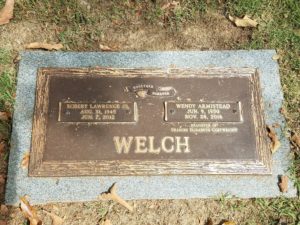 The Final Footprint – Memorial Park Cemetery in Memphis. Other notable final footprints at Memorial Park include; Bobby Bland, Isaac Hayes, Sam Phillips, and Charlie Rich.
The Final Footprint – Memorial Park Cemetery in Memphis. Other notable final footprints at Memorial Park include; Bobby Bland, Isaac Hayes, Sam Phillips, and Charlie Rich.
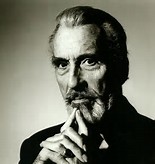 On this day in 2015, actor, singer, and author Christopher Lee died at the Chelsea and Westminster Hospital, Chelsea, London, after being admitted for respiratory problems and heart failure, shortly after celebrating his 93rd birthday. Born Christopher Frank Carandini Lee in Belgravia, Westminster, London, on 27 May 1922. With a career spanning nearly 70 years, Lee initially portrayed villains and became known for his role as Count Dracula in a sequence of Hammer Horror films. His other film roles include Francisco Scaramanga in the James Bond film The Man with the Golden Gun (1974), Saruman inThe Lord of the Rings film trilogy (2001–2003) and The Hobbit film trilogy (2012–2014), and Count Dooku in the final two films of the Star Wars prequel trilogy (2002 and 2005).
On this day in 2015, actor, singer, and author Christopher Lee died at the Chelsea and Westminster Hospital, Chelsea, London, after being admitted for respiratory problems and heart failure, shortly after celebrating his 93rd birthday. Born Christopher Frank Carandini Lee in Belgravia, Westminster, London, on 27 May 1922. With a career spanning nearly 70 years, Lee initially portrayed villains and became known for his role as Count Dracula in a sequence of Hammer Horror films. His other film roles include Francisco Scaramanga in the James Bond film The Man with the Golden Gun (1974), Saruman inThe Lord of the Rings film trilogy (2001–2003) and The Hobbit film trilogy (2012–2014), and Count Dooku in the final two films of the Star Wars prequel trilogy (2002 and 2005).
Lee was knighted for services to drama and charity in 2009, received the BAFTA Fellowship in 2011 and received the BFI Fellowship in 2013. Noted as an actor for his deep strong voice, Lee was also known for his singing ability, recording various opera and musical pieces between 1986 and 1998 and the symphonic metal album Charlemagne: By the Sword and the Cross in 2010. The heavy metal follow-up titled Charlemagne: The Omens of Death was released on 27 May 2013. He was honoured with the “Spirit of Metal” award at the 2010 Metal Hammer Golden God awards ceremony. Lee married Danish painter and former model Birgit “Gitte” Krøncke (1961-2015).
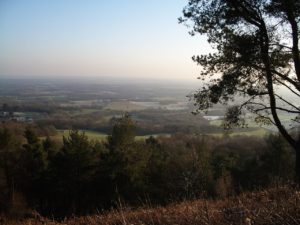 The Final Footprint – Cremains scattered, Surrey Hills in England.
The Final Footprint – Cremains scattered, Surrey Hills in England.
Have you planned yours yet?
Follow TFF on twitter @RIPTFF


Pingback: Jean Harlow baby | Celebrities 24x7
How about christopher lee the actor he died 7th june can yopu please add him in
Thank you for the comment. Just posted Mr. Lee.